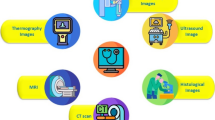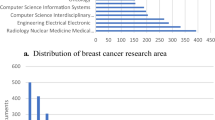Abstract
Deep learning (DL) is the most rapidly expanding in the current scenario. For image analysis and categorization, deep neural networks (DNNs) are presently the most extensively utilized technology. DNN designs include GoogleNet, residual networks, and AlexNet, among others. Breast cancer is seen as a major problem that endangers the lives and health of women. Ultrasonography or MRI scanning methods are used to diagnose breast cancer disease. Imaging methods used for diagnosis include digital mammography, ultrasonography, magnetic resonance imaging, and infrared thermography. The primary objective is to investigate different deep learning algorithms for recognizing breast cancer-affected imageries. The best models provide accuracy for the 2, 4, and classifications on cancer datasets. No previous research is carried out for the current model investigation. Early detection and screening are critical for effective therapy. The following is a synopsis of recent progress in mammograms and identification, as well as a discussion of technological advancements. An effective test result should meet the following requirements: performance, sensitivity, specificity, precision, recall, and low cost. The experimental settings for every study on breast cancer histopathology images are thoroughly reviewed and deliberated in this article.
Access this chapter
Tax calculation will be finalised at checkout
Purchases are for personal use only
Similar content being viewed by others
References
Eastland TY (2017) Prostate cancer screening in the African American community: the female impact
Tasnim Z, Shamrat FMJM, Islam MS, Rahman MT, Aronya BS, Muna JN, Billah MM (2021) Classification of breast cancer cell images using multiple convolution neural network architectures. International Journal of Advanced Computer Science and Applications 12(9)
Vesal S, Ravikumar N, Davari AA, Ellmann S, Maier A (2018)Classification of breast cancer histology images using transfer learning, image analysis and recognition. Springer, Cham
Robertson S, Azizpour H, Smith K, Hartman J (2017) Digital image analysis in breast pathology—from image processing techniques to artificial intelligence. Translational Research 1931–5244
Javed S, Mahmood A, Ullah I, Bouwmans T, Khonji M, Dias JMM, Werghi N (2022) A novel algorithm based on a common subspace fusion for visual object tracking. IEEE Access 10:24690–24703
Hwang Y, Cho E, Park N (2022) Development of teaching-learning contents for AI core principles at the elementary school level: with a focus on convolutional neural network. Webology 19(1)
Jurisica I (2022) Integrative computational biology, AI, and radiomics: building explainable models by integration of imaging, omics, and clinical data. In: Artificial intelligence/machine learning in nuclear medicine and hybrid imaging. Springer, Cham, pp 171–189
Vibert F, Martel C, Ionescu RA, Mathelin C, Ame S (2022) A new modality for breast cancer diagnosis during the COVID-19 pandemic: a case report. European Journal of Breast Health 18(1):91
Abed GA, Wahab SDA, Elamrosy SH, Hamied MMA (2020) Effect of breast cancer on psychological status among breast cancer patients. International Journal of Novel Research in Healthcare and Nursing 7(2):393–402
Dabass J (2020) Pectoral muscle and breast density segmentation using modified region growing and K-means clustering algorithm. In: Data communication and networks. Springer, Singapore, pp 331–339
Singh A, Gutte V (2022) Classification of breast tumor using ensemble learning. In: Mobile computing and sustainable informatics. Springer, Singapore, pp 491–507
Alfi IA, Rahman MM, Shorfuzzaman M, Nazir A (2022) A non-invasive interpretable diagnosis of melanoma skin cancer using deep learning and ensemble stacking of machine learning models. Diagnostics 12(3):726
Masek M, Christopher JS, Attikiouzel Y (2003) Automatic breast orientation in mediolateral oblique view mammograms. In: Digital mammography: IWDM 2002—6th international workshop on digital mammography. Springer, p 207
Digital mammography dream challenge dataset, n.d. https://www.synapse.org/#!Synapse:syn4224222/wiki/401743. Accessed 3 Nov 2019
Jia W, Jiang Y (2017) Comparison of detection methods based on computer vision and machine learning. In: 2017 international conference on mechanical, electronic, control and automation engineering (MECAE 2017). Atlantis Press, pp 386–390
Boryczko K, Kurdziel M, Yuenb DA (2007) Detecting clusters of microcalcifications in high-resolution mammograms using support vector machines. Poland: Institute of Computer Science, USA: Minnesota Supercomputing Institute
Walia H, Kaur P (2021) A quantitative analysis for breast cancer prediction using artificial neural network and support vector machine. In: International conference on soft computing and signal processing. Springer, Singapore, pp 59–82
Bacha S, Abdellafou KB, Aljuhani A, Taouali O, Liouane N (2022) Early detection of digital mammogram using kernel extreme learning machine. Concurrency and Computation: Practice and Experience, e6971
Toprak A (2018) Extreme learning machine (elm)-based classification of benign and malignant cells in breast cancer. Medical Science Monitor: International Medical Journal of Experimental and Clinical Research 24:6537
Marinovich ML, Wylie E, Lotter W, Pearce A, Carter SM, Lund H, Waddell A et al (2022) Artificial intelligence (AI) to enhance breast cancer screening: protocol for population-based cohort study of cancer detection. BMJ Open 12(1):e054005
Javed R, Rahim MSM, Saba T, Sahar G, Awan MJ (2022) An accurate skin lesion classification using fused pigmented deep feature extraction method. In: Prognostic models in healthcare: AI and statistical approaches. Springer, Singapore, pp 47–78
Ratanachaikanont T (2005) Clinical breast examination and its relevance to the diagnosis of a palpable breast lesion. J Med Assoc Thai 88(4):505–507
Kosters JP, Gotzsche PC (2003) Regular self-examination or clinical examination for early detection of breast cancer. Cochrane Database of Systematic Reviews 2, Article ID CD003373
Amoah C, Somhlaba NZ, Addo F-M, Amoah VMK, Ansah EOA, Adjaottor ES, Amankwah GB, Amoah B (2021) A preliminary psychometric assessment of the attitude of health trainee undergraduate students towards breast-self examination in Ghana
Madubogwu CI, Madubogwu NU, Azuike EC (2021) Practice of breast self-examination among female students of Chukwuemeka Odumegwu Ojukwu University, Awka. Journal of Health Science Research 10–18
Hanis TM, Islam MA, Musa KI (2022) Diagnostic accuracy of machine learning models on mammography in breast cancer classification: a meta-analysis. Diagnostics 12(7):1643
Sadovsky R (2003) Factors affecting the accuracy of mammography screening. Am Fam Physician 68(6):1198
Dai X, Fu G, Reese R, Zhao S, Shang Z (2021) An approach of Bayesian variable selection for ultrahigh dimensional multivariate regression. Stat e476
Wang Z, Sun X, Sun L, Qian X (2013) Tissue classification using efficient local fisher discriminant analysis. Przegląd Elektrotechniczny 89(3b):113–115
Hernandez JCH, Duval B, Hao J-K, A counting technique based on SVM-RFE for selection and classification of microarray data. Advances in Computer Science and Engineering 99
Koul N, Manvi SS (2020) Ensemble feature selection from cancer gene expression data using mutual information and recursive feature elimination. In: 2020 third international conference on advances in electronics, computers and communications (ICAECC). IEEE, pp 1–6
Syafiandini AF, Wasito I, Mufidah R, Veritawati I, Budi I (2018) Prediction of breast cancer recurrence using modified kernel based data integration model. Journal of Theoretical and Applied Information Technology 96(16):5489–5498
Broadwater DR, Smith NE (2018) A fine-tuned inception v3 constitutional neural network (CNN) architecture accurately distinguishes between benign and malignant breast histology. 59 MDW San Antonio United States
Dandil E, Selvi AO, Çevik KK, Yildirim MS, Süleyman UZUN (2021) A hybrid method based on feature fusion for breast cancer classification using histopathological images. Avrupa Bilim ve Teknoloji Dergisi 29:129–137
Liao H (2016) A deep learning approach to universal skin disease classification, CSC 400-Graduate Problem Seminar-Project Report
Oh J (2020) Potential of disease prediction using deep learning algorithms. Science 5(4):283–286
Namwongse P, Limpiyakorn Y (2012) Learning Bayesian network to explore connectivity of risk factors in enterprise risk management. International Journal of Computer Science Issues (IJCSI) 9(2):61
Zavareh PH, Safayari A, Bolhasani H (2021) BCNet: a deep convolutional neural network for breast cancer grading. arXiv preprint arXiv:2107.05037
de Boo LW, Jóźwiak K, Joensuu H, Lindman H, Lauttia S, Opdam M, van Steenis C et al (2022) Adjuvant capecitabine-containing chemotherapy benefit and homologous recombination deficiency in early-stage triple-negative breast cancer patients. British Journal of Cancer 126(10):1401–1409
Author information
Authors and Affiliations
Corresponding author
Editor information
Editors and Affiliations
Rights and permissions
Copyright information
© 2023 The Author(s), under exclusive license to Springer Nature Singapore Pte Ltd.
About this paper
Cite this paper
Kalavathi, R., Swamy Das, M. (2023). A Review on Deep Learning Approaches for Histopathology Breast Cancer Classification. In: Reddy, K.A., Devi, B.R., George, B., Raju, K.S., Sellathurai, M. (eds) Proceedings of Fourth International Conference on Computer and Communication Technologies. Lecture Notes in Networks and Systems, vol 606. Springer, Singapore. https://doi.org/10.1007/978-981-19-8563-8_35
Download citation
DOI: https://doi.org/10.1007/978-981-19-8563-8_35
Published:
Publisher Name: Springer, Singapore
Print ISBN: 978-981-19-8562-1
Online ISBN: 978-981-19-8563-8
eBook Packages: Intelligent Technologies and RoboticsIntelligent Technologies and Robotics (R0)




